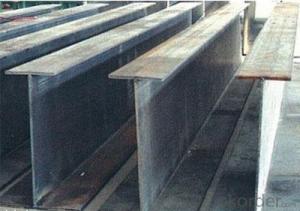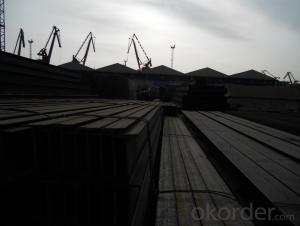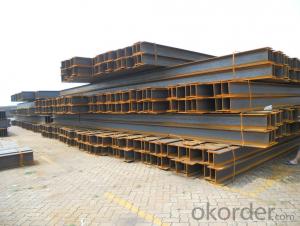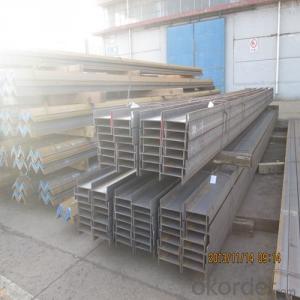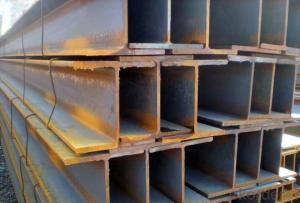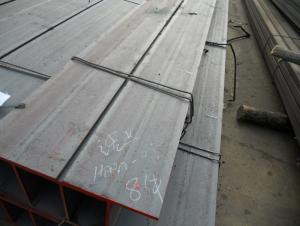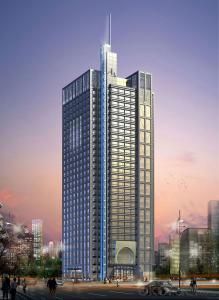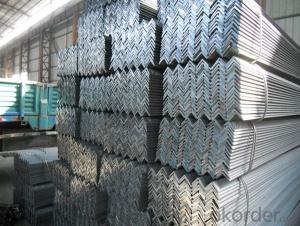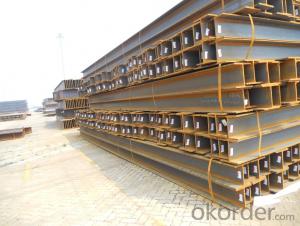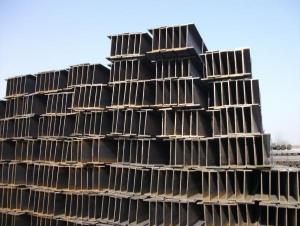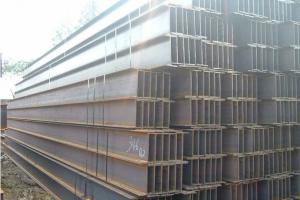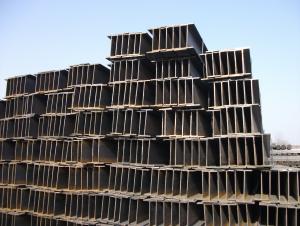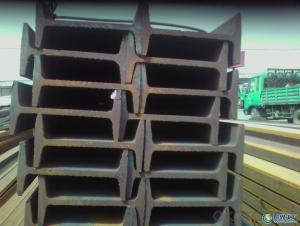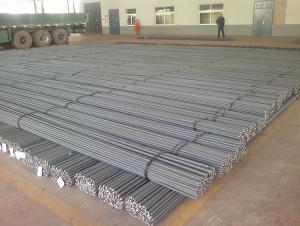100mm*100*6.0*8*16.9kg/m H BEAM for construction
- Loading Port:
- Tianjin
- Payment Terms:
- TT or LC
- Min Order Qty:
- 25 m.t.
- Supply Capability:
- 100000 m.t./month
OKorder Service Pledge
OKorder Financial Service
You Might Also Like
Product Description:
Specifications of Hot Rolled Structural Steel H Beam
1. Standard: GB700-88, Q235B2.
2. Grade: Q235, SS400 or Equivalent
3. Length: 6m,10m, 12m as following table
4. Invoicing on theoretical weight or actual weight as customer request
5.Payment: TT or L/C
Packaging & Delivery of Hot Rolled Structural Steel H Beam
1. Packing: it is nude packed in bundles by steel wire rod
2. Bundle weight: not more than 3.5MT for bulk vessel; less than 3 MT for container load
3. Marks:
Color marking: There will be color marking on both end of the bundle for the cargo delivered by bulk vessel. That makes it easily to distinguish at the destination port.
Tag mark: there will be tag mark tied up on the bundles. The information usually including supplier logo and name, product name, made in China, shipping marks and other information request by the customer.
If loading by container the marking is not needed, but we will prepare it as customer request.
4. Transportation: the goods are delivered by truck from mill to loading port, the maximum quantity can be loaded is around 40MTs by each truck. If the order quantity cannot reach the full truck loaded, the transportation cost per ton will be little higher than full load.
5. Delivered by container or bulk vessel
Packaging & Delivery of Hot Rolled Structural Steel H-beam with all Size
1. Packing: it is nude packed in bundles by steel wire rod
2. Bundle weight: not more than 3.5MT for bulk vessel; less than 3 MT for container load
3. Marks:
Color marking: There will be color marking on both end of the bundle for the cargo delivered by bulk vessel. That makes it easily to distinguish at the destination port.
Tag mark: there will be tag mark tied up on the bundles. The information usually including supplier logo and name, product name, made in China, shipping marks and other information request by the customer.
If loading by container the marking is not needed, but we will prepare it as customer request.
4. Transportation: the goods are delivered by truck from mill to loading port, the maximum quantity can be loaded is around 40MTs by each truck. If the order quantity cannot reach the full truck loaded, the transportation cost per ton will be little higher than full load.
5. Delivered by container or bulk vessel
Production flow of Hot Rolled Structural Steel H Beam
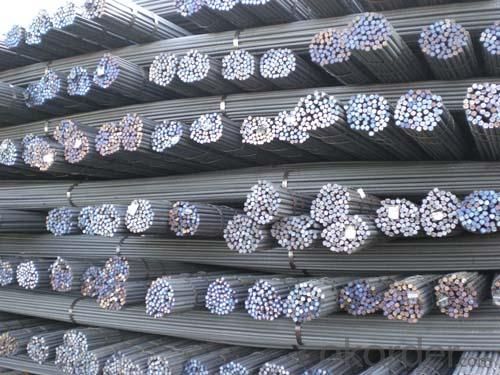
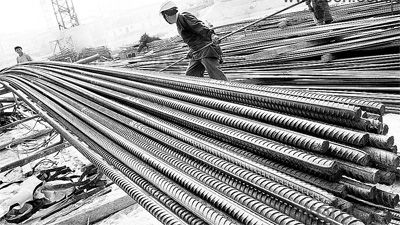
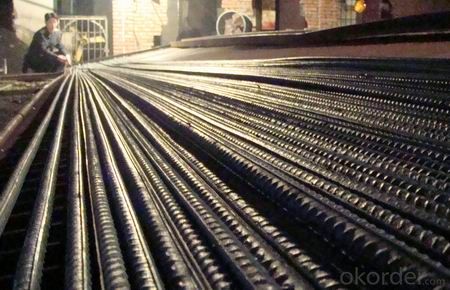
- Q: Can steel H-beams be used in sports stadium construction?
- Indeed, sports stadium construction can indeed incorporate the use of steel H-beams. These beams are widely utilized in construction as they possess remarkable strength, durability, and load-bearing capabilities. They offer exceptional support for expansive spans and substantial loads, rendering them ideal for constructing grandstands, roofs, and other structural elements within sports stadiums. The H-shape of these beams enables efficient weight distribution and imparts stability, thereby ensuring the safety of the stadium structure. Additionally, steel beams can be customized in terms of size and length, exhibiting versatility and adaptability to fulfill the specific requirements of each stadium project. All in all, owing to their strength, versatility, and ability to withstand the demanding loads and conditions associated with such structures, steel H-beams have emerged as a favored choice in sports stadium construction.
- Q: What are the different surface finishes available for steel H-beams?
- There are several different surface finishes available for steel H-beams, each offering unique properties and advantages. Some of the most common surface finishes for steel H-beams include: 1. Mill finish: This is the standard finish directly from the steel mill, which has a somewhat rough texture and may contain minor imperfections. Mill finish is typically used for structural applications where aesthetics are not a priority. 2. Hot-dip galvanized: This surface finish involves immersing the steel H-beam in a bath of molten zinc, which creates a protective layer that prevents corrosion. Hot-dip galvanizing is commonly used for outdoor structures or applications that will be exposed to harsh environments. 3. Painted: Steel H-beams can be coated with paint for both aesthetic and protective purposes. Painted finishes provide a wide range of color options and can also offer additional corrosion resistance. 4. Powder-coated: Powder coating is a type of paint finish that is applied electrostatically as a dry powder and then cured under heat. This process creates a durable and attractive finish that is resistant to chipping, scratching, and fading. 5. Primed: Priming involves applying a layer of primer to the steel H-beam before any additional finish is applied. Primers help improve adhesion of subsequent coatings and provide an additional layer of protection against corrosion. 6. Stainless steel: Instead of surface finishes, stainless steel H-beams are often left with a natural finish due to their inherent corrosion resistance. The stainless steel material itself provides excellent durability and resistance to staining or rusting. It is important to consider the specific application and environment when selecting a surface finish for steel H-beams. Factors such as durability, resistance to corrosion, aesthetics, and cost will all play a role in determining the most suitable finish. Consulting with a steel supplier or specialist can help ensure the best choice for your particular needs.
- Q: Can steel H-beams be used in the construction of agricultural buildings?
- Agricultural buildings can utilize steel H-beams for their construction. These beams are widely favored in the construction industry due to their strength, durability, and versatility. They possess exceptional load-bearing capacity, which enables them to support the weight of the building and any additional equipment or machinery stored within. Moreover, steel H-beams are resistant to rot, pests, and fire, making them highly suitable for agricultural buildings that may face harsh environmental conditions. What's more, these beams can be easily fabricated and customized to precisely fit the specific requirements of the agricultural structure, ensuring optimal structural integrity. Overall, steel H-beams provide numerous benefits for agricultural construction projects, which is why they are highly preferred by architects, engineers, and farmers.
- Q: How do you calculate the moment capacity of steel H-beams?
- To calculate the moment capacity of steel H-beams, you need to consider the properties of the beam, including the dimensions and material properties. The moment capacity, also known as the bending strength or flexural strength, is a measure of the beam's ability to resist bending forces. The moment capacity of a steel H-beam can be calculated using the following steps: 1. Determine the section properties: The first step is to calculate the section properties of the H-beam, such as the moment of inertia (I) and the section modulus (Z). These properties depend on the dimensions of the beam, including the flange width, flange thickness, web height, and web thickness. These properties can be found in structural design manuals or obtained from the manufacturer's specifications. 2. Determine the yield strength: The next step is to determine the yield strength (Fy) of the steel material used in the H-beam. This value represents the maximum stress that the steel can withstand without permanent deformation. The yield strength can also be obtained from design manuals or manufacturer's specifications. 3. Calculate the plastic moment capacity: The plastic moment capacity (Mp) is the maximum moment that the beam can resist before it starts to yield (plastic deformation). It is calculated by multiplying the yield strength (Fy) by the section modulus (Z). The formula for calculating the plastic moment capacity is Mp = Fy * Z. 4. Determine the allowable moment capacity: The plastic moment capacity is not always the limiting factor in design. Depending on the design requirements and safety factors, the allowable moment capacity may be lower than the plastic moment capacity. The allowable moment capacity is calculated by multiplying the plastic moment capacity by a factor of safety (Fs). The factor of safety accounts for uncertainties in materials, loads, and other design considerations. The formula for calculating the allowable moment capacity is Ma = Mp * Fs. By following these steps, you can calculate the moment capacity of steel H-beams and ensure that the beam is designed to withstand the required bending forces in a safe and efficient manner. It is important to consult design codes, standards, and structural engineering principles to ensure the accuracy and reliability of the calculations.
- Q: How are steel H-beams classified based on weight capacity?
- Steel H-beams are classified based on their weight capacity by using a system called the "beam designation." The beam designation consists of a number followed by the letters "UB" or "UC." The number in the beam designation indicates the depth of the beam in millimeters, while the letters indicate the type of beam. "UB" stands for Universal Beam, which has wider flanges compared to its depth. "UC" stands for Universal Column, which has equal width and depth dimensions. The weight capacity of steel H-beams is directly related to their size and shape. Generally, the higher the number in the beam designation, the higher the weight capacity. For example, a beam with a designation of UB 203x133 has a depth of 203 millimeters and a weight capacity that is higher than a beam with a designation of UB 152x89, which has a depth of 152 millimeters. It is important to note that weight capacity is also influenced by other factors such as the material grade and the specific H-beam profile. Therefore, it is essential to consult engineering tables or professionals to determine the exact weight capacity of a specific steel H-beam.
- Q: What are the common surface treatments available for steel H-beams?
- Steel H-beams have a variety of surface treatments available to enhance durability, appearance, and corrosion resistance. Some common treatments include: 1. Hot-dip galvanizing: Immersing the beams in molten zinc forms a protective coating, providing excellent corrosion resistance for outdoor or high-moisture environments. 2. Powder coating: A dry powder is applied to the beams, then heated and fused onto the metal, creating a durable and attractive finish that resists chipping, scratching, and fading. 3. Epoxy coating: This treatment adds a protective layer that resists corrosion, chemicals, and abrasion, making it suitable for industrial settings with harsh substances. 4. Painting: A popular treatment for steel H-beams, painting offers aesthetic appeal and corrosion protection. Beams are primed and coated with high-quality, weather and UV-resistant paint. 5. Shot blasting: Small metallic or abrasive particles are propelled at high speeds onto the beams' surface, removing rust, mill scale, and impurities, leaving a clean and roughened surface for further treatment. Choosing the appropriate surface treatment for steel H-beams depends on specific requirements, including application, environmental conditions, and aesthetic preferences. Factors like cost, durability, maintenance, and expected lifespan should be considered when selecting the most suitable treatment.
- Q: Can steel H-beams be used for shopping centers?
- Yes, steel H-beams can be used for shopping centers. Steel H-beams are commonly used in commercial construction, including shopping centers, due to their strength, durability, and ability to support heavy loads.
- Q: What are the considerations when designing for sustainable materials in Steel H-Beams?
- When designing for sustainable materials in Steel H-Beams, there are several key considerations that need to be taken into account. These considerations revolve around the environmental impact, cost-effectiveness, durability, and overall sustainability of the materials used. 1. Environmental Impact: One of the primary considerations when designing with sustainable materials is to minimize the environmental impact throughout the lifecycle of the H-Beams. This includes sourcing materials from responsibly managed forests or using recycled steel to reduce deforestation and minimize carbon emissions. 2. Energy Efficiency: Another important consideration is the energy efficiency of the manufacturing process. Designers should strive to reduce energy consumption and greenhouse gas emissions by selecting materials that require less energy to produce or using energy-efficient manufacturing techniques. 3. Durability and Longevity: Sustainable materials should be durable and have a long lifespan. By designing H-Beams that are resistant to corrosion, wear, and tear, it reduces the need for frequent replacements, minimizing waste and resource consumption. 4. Recyclability: The ability to recycle and reuse materials is crucial in sustainable design. Steel H-Beams should be designed in a way that allows for easy disassembly and recycling at the end of their lifespan. This promotes a circular economy and reduces the demand for new raw materials. 5. Cost-effectiveness: While sustainability is a key goal, it is also important to consider the cost-effectiveness of the materials used. Designers should aim to strike a balance between sustainability and affordability, ensuring that the use of sustainable materials does not compromise the overall project budget. 6. Compliance with Standards and Certifications: Designers should consider materials that meet recognized sustainability standards and certifications. This includes certifications like LEED (Leadership in Energy and Environmental Design) or Cradle to Cradle, which ensure that the materials have been responsibly sourced and manufactured. 7. Collaborative Approach: Lastly, it is crucial to involve stakeholders, including architects, engineers, and manufacturers, in the decision-making process. By collaborating and sharing knowledge, the design team can identify innovative solutions that promote sustainability and address any challenges related to using sustainable materials in Steel H-Beams.
- Q: Can Steel H-Beams be used in airport or transportation terminal construction?
- Yes, steel H-beams can be used in airport or transportation terminal construction. They are often utilized in the construction of large-scale structures due to their strength, durability, and ability to support heavy loads. Steel H-beams provide structural stability and can effectively withstand the dynamic forces experienced in airport or transportation terminal environments.
- Q: What are the common maintenance practices for steel H-beams?
- To maintain steel H-beams, it is necessary to conduct frequent visual inspections to detect any signs of damage or degradation, such as cracks, rust, or bending. It is important to regularly clean the beams to eliminate any debris or contaminants that may contribute to corrosion. Moreover, it is advisable to apply protective coatings like paint or galvanization to prevent rust and corrosion. These coatings should be inspected regularly and reapplied when needed. Regarding structural stability, it is crucial to ensure proper support for the H-beams and avoid subjecting them to excessive loads or stress. Regular assessments of the loads should be carried out to identify any potential issues and take appropriate measures to resolve them. In addition, monitoring the environment in which the H-beams are installed is crucial. Factors such as temperature, humidity, and exposure to chemicals or corrosive substances can affect their performance and durability. Taking necessary precautions and implementing measures to mitigate these risks is vital to maintain the longevity of the steel H-beams. Overall, regular inspections, cleaning, protective coatings, load assessments, and monitoring environmental conditions are essential maintenance practices for steel H-beams to ensure their structural integrity and prevent potential damage or degradation.
Send your message to us
100mm*100*6.0*8*16.9kg/m H BEAM for construction
- Loading Port:
- Tianjin
- Payment Terms:
- TT or LC
- Min Order Qty:
- 25 m.t.
- Supply Capability:
- 100000 m.t./month
OKorder Service Pledge
OKorder Financial Service
Similar products
Hot products
Hot Searches
Related keywords
